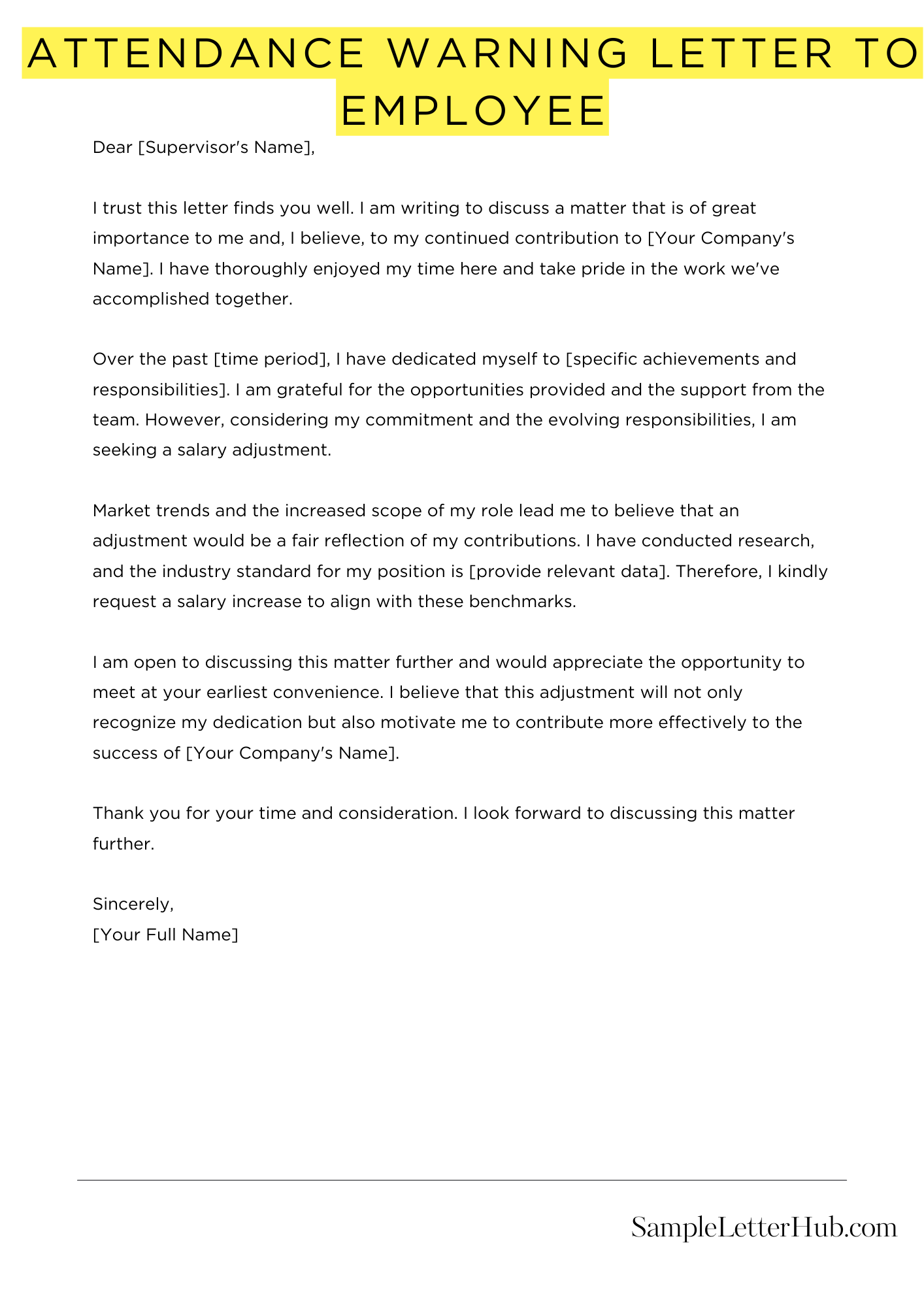An attendance warning letter is a formal document issued by an employer to an employee who has violated the company’s attendance policy. The purpose of the letter is to document the employee’s attendance issues, warn them of the potential consequences of continued violations, and provide them with an opportunity to improve their attendance.
In this article, we will share several templates, examples, and samples of attendance warning letters. These letters are designed to help you write a clear and concise letter that effectively communicates the company’s attendance policy and the consequences of violating it.
Attendance Warning Letter
Dear [Employee Name],
This letter serves as a formal warning regarding your recent attendance record.
Over the past [number] months, you have been consistently absent or late for work. Specifically, you have been:
* Absent for [number] days without prior notice.
* Late for work [number] times by more than [number] minutes.
Your attendance has been impacting the team’s productivity and morale. It has also raised concerns about your reliability and commitment to your role.
We understand that occasional absences or tardiness may occur due to unforeseen circumstances. However, your recent attendance pattern has become a significant issue.
We have discussed this matter with you previously and have provided guidance on improving your attendance. However, we have not seen any significant improvement.
Therefore, we are issuing this formal warning to give you the opportunity to address this issue and avoid further disciplinary action.
You are required to take immediate steps to improve your attendance. This includes:
* Providing advance notice for any planned absences.
* Arriving on time for work or contacting your supervisor if you are running late.
* Seeking medical attention if you are experiencing any health issues that may affect your attendance.
We will monitor your attendance closely over the next [number] weeks. If your attendance does not improve significantly, we may consider further disciplinary action, including suspension or termination of employment.
We encourage you to meet with your supervisor to discuss this matter further and develop a plan to improve your attendance.
Please acknowledge receipt of this letter by signing and returning a copy to your supervisor.
Sincerely,
[Your Name]

How to Write Attendance Warning Letter To Employee
Writing an attendance warning letter to an employee can be a difficult task. You want to be clear and concise, but you also want to be fair and respectful. Here are a few tips on how to write an effective attendance warning letter:
1. Start with a clear statement of the problem.
The first step is to clearly state the problem that you are addressing. This could be anything from excessive absences to tardiness. Be sure to include specific dates and times, if possible.
2. Explain the company’s attendance policy.
Once you have stated the problem, you need to explain the company’s attendance policy. This will help the employee understand what is expected of them and why they are being disciplined.
3. State the consequences of continued attendance problems.
If the employee continues to have attendance problems, it is important to state the consequences. This could include anything from a verbal warning to a written warning to termination of employment.
4. Offer support and assistance.
In addition to stating the consequences, you should also offer support and assistance to the employee. This could include providing them with resources to help them improve their attendance, such as an employee assistance program or a flexible work schedule.
5. Be fair and respectful.
It is important to be fair and respectful when writing an attendance warning letter. This means being clear and concise, but also being understanding and supportive. Remember that the goal of the letter is to help the employee improve their attendance, not to punish them.
6. Keep a copy of the letter.
Once you have written the letter, be sure to keep a copy for your records. This will help you track the employee’s progress and take further action if necessary.
7. Follow up with the employee.
After you have written the letter, it is important to follow up with the employee. This could involve meeting with them to discuss the letter or simply checking in with them on a regular basis to see how they are doing.
FAQs about Attendance Warning Letter To Employee
What is an Attendance Warning Letter?
An attendance warning letter is a formal communication issued by an employer to an employee who has violated the company’s attendance policy. It serves as a written record of the employee’s attendance issues and outlines the consequences of continued violations.
When should an Attendance Warning Letter be issued?
An attendance warning letter should be issued when an employee has exceeded the allowable number of absences or tardinesses within a specified period. The specific threshold for issuing a warning letter may vary depending on the company’s attendance policy.
What should an Attendance Warning Letter include?
An attendance warning letter should typically include the following information:
- Employee’s name and job title
- Date of the letter
- Summary of the employee’s attendance record, including specific instances of absences or tardinesses
- Statement of the company’s attendance policy
- Consequences of continued attendance violations
- Steps the employee can take to improve attendance
- Signature of the issuing manager
What are the consequences of receiving an Attendance Warning Letter?
The consequences of receiving an attendance warning letter can vary depending on the company’s policies and the severity of the attendance violations. Common consequences include:
- Verbal or written reprimand
- Suspension without pay
- Termination of employment
What should an employee do if they receive an Attendance Warning Letter?
If an employee receives an attendance warning letter, they should take the following steps:
- Review the letter carefully and understand the reasons for the warning.
- Acknowledge the receipt of the letter and sign it if required.
- Meet with their manager to discuss the attendance issues and develop a plan to improve attendance.
- Follow the steps outlined in the letter to improve attendance and avoid further consequences.

